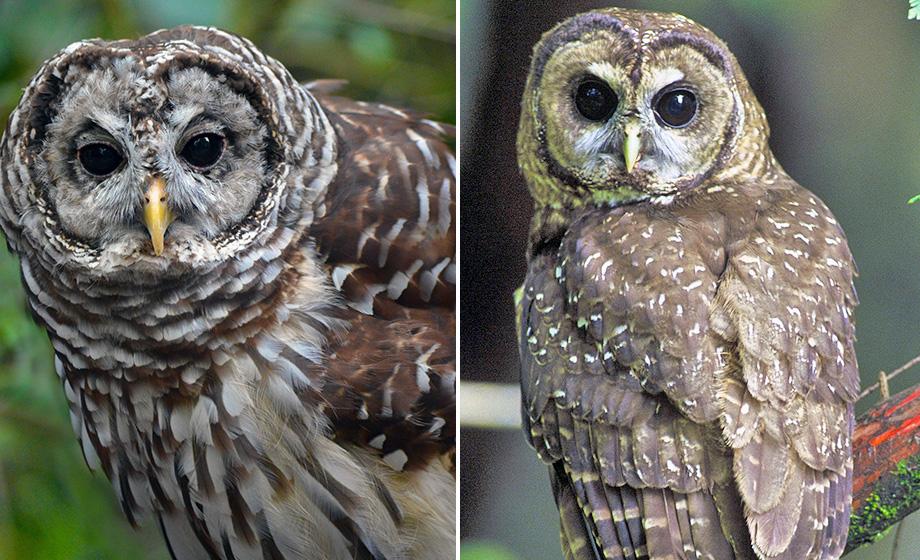
The Pacific Northwest is in the middle of “Owl Wars,” in which the possible extinction of the northern spotted owl is being weighed against the intrusion of another — the barred owl. After a decade of planning, the U.S. Fish and Wildlife Service (FWS) has concluded that the only way to save the spotted owl from extinction is to kill barred owls, a move that is ethically troubling for bird and nature lovers everywhere.
Since 2009, the FWS has held public hearings on the issue featuring experts such as William Lynn, an ethicist and research scientist with Clark’s George Perkins Marsh Institute.

“I went in profoundly skeptical,” Lynn told bioGraphic, a multimedia magazine affiliated with the California Academy of Sciences. “This changed me.”
In an earlier story for CLARK alumni magazine, Lynn said he had weighed all sides of the issue before sanctioning the FWS decision. On the one hand, he recognizes that “barred owls have moral value, too, and we cannot kill our way back to biodiversity.” In addition, Lynn says, “in the long run, restoring habitat and finding non-lethal alternatives is the only ethical answer.”
Yet spotted owls need our help now or they will go extinct in the wild, he points out. As Lynn noted when contacted about this story, “it is a tragic choice to kill barred owls for the benefit of spotted owls – one entirely of our own making in destroying the old-growth forests of the Pacific Northwest.”
In her story in bioGraphic, Emily Sohn spells out the complex ethical and scientific issues and the hard facts that have spurred the government to take action:
“What is increasingly clear is that barred owls are adaptable colonizers, if not outright bullies. For one study, [United States Geological Survey biologist David] Wiens’s team put radio tags on 29 spotted owls and 28 barred owls in western Oregon to follow their every move. Results, published in 2014, showed that barred owls are bad for spotted owls in just about every way, including family planning. The closer spotted owls lived to barred owls, the less likely they were to produce young.
“It’s easy to see why. Barred owls are bigger and more aggressive in defense of their territories; sometimes they even attack people in parks. Unlike spotted owls, barred owls will eat almost anything, including salamanders, crayfish, crickets, worms, and small birds. And they’re more tolerant of crowding. Wiens frequently sees two or three pairs of barred owls in territories that used to be claimed by just one pair of spotted owls.
“The power dynamic is not going well for spotted owls. In a study published earlier this year, scientists documented a steady decline of about 4 percent per year in sites around Washington, Oregon, and California. Overall, from 1985 to 2013, spotted owl numbers dropped as much as 80 percent in some areas of the Pacific Northwest. Barred owls have surpassed northern spotted owls in numbers throughout their range.”
The possible extinction of the northern spotted owl – an icon of the Pacific Northwest forest – has concerned environmentalists for decades. In the 1980s, the spotted owl became the center of a heated debate, pitting longtime logging families and the timber industry against conservation-minded West Coasters, the nation’s leading environmental groups and the U.S. government.
That controversy resulted in the U.S. Forest Service’s Northwest Forest Plan, which limits logging on most of the 24.5 million designated acres of public land in Oregon, Washington and northern California. The idea was to protect not only the spotted owl but over 1,000 other wildlife and aquatic species in the old-growth ecosystems.
Like the past controversy, the recent public meetings over the future of the spotted owl-barred owl interrelationship show how difficult it can be to strike a human-imposed balance – and why the guidance of bioethicists like Lynn is so crucial.
“Ethics reviews of public policy — like the one conducted for managing barred and spotted owls,” he said in the recent interview, “force a hard look at our moral values, clarify the ethical issues around pressing environmental and social issues and help guide political decisions so we can meet our moral responsibilities to people, animals and nature.”
